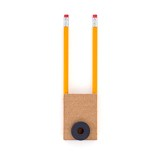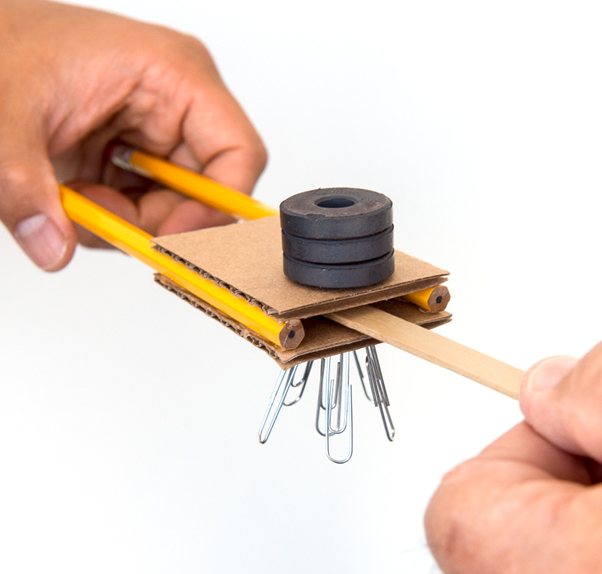Magnetism and electricity: Identify, describe and apply principles of magnetism
Unit 3: Magnetic shielding
Leigh Kleynhans
Unit outcomes
By the end of this unit you will be able to:
- Describe magnetic shielding
- Describe the underlying principles of magnetic shielding
- Describe the purpose of magnetic shielding.
What you should know
Before you start this unit, make sure you:
- Understand the principles of magnets and magnetic fields, as covered in Subject outcome 4.1, Unit 1.
- Understand the principles of the Earth’s magnetic field, as covered in Subject outcome 4.1, Unit 2.
Introduction
is the practice of reducing the magnetic field in a space by blocking the field with barriers made of conductive or magnetic materials. Shielding is typically applied to enclosures to isolate electrical devices from their surroundings, and to cables to isolate wires from the environment through which the cable runs. This can be done with several materials, including sheet metal, metal mesh, ionized gas, or plasma. The purpose is most often to prevent magnetic fields from interfering with electrical devices.
How does it work?
Instead of attempting to stop these magnetic field lines, magnetic shielding re-routes them around an object. This is done by surrounding the device to be shielded with a magnetic material. describes the ability of a material to be magnetised. If the material used has a greater permeability than the objects inside, the magnetic field will tend to flow along this material, avoiding the objects inside. Thus, the magnetic field lines are redirected.
The most effective shielding material available is mu-metal — an of 77% nickel, 16% iron, 5% copper and 2% chromium — which is then heated in a hydrogen atmosphere to increase its permeability. As mu-metal is extremely expensive, other alloys with similar compositions are sold for shielding purposes, usually in rolls of foil.
Activity 3.1: Investigate which materials can act as a magnetic shield
Time required: 30 minutes
What you need:

- three round ceramic magnets (rectangular magnets will also work)
- two pieces of cardboard of equal size, about 5 x 7 centimetres
- two pencils, 7 cm or longer
- five or six paper clips
- a wood craft stick (ice cream stick), a plastic straw, or any other non-metallic material
- a steel knife
- a hot-glue gun and glue (alternatively, you can use rubber bands)
What to do:
You will test different materials to see which of them gather magnetic lines of force and act as magnetic shields, and which allow magnetic lines of force to pass through them.
- Make a cardboard-pencil sandwich: Attach the pencils to one piece of cardboard, placing the pencils parallel to each other and close to the opposite edges of the cardboard (see the photo below). Glue the second piece of cardboard to the pencils so that you end up with a cardboard-pencil-cardboard sandwich.
- Secure one of the magnets to the top piece of cardboard with hot glue. Centre the magnet near one of the edges (see the photo below).

- Add two more magnets on top of the first one so that they are held in place by magnetic attraction. Do not glue them!
- Hold your shielding sandwich with the magnets on top. Lift the paper clips one at a time from the bottom side and notice what happens (see the photo below). The paper clips should be attracted to the magnet and so will hang from the bottom of the cardboard sandwich.

- As you add more paper clips, notice what happens. If you add them carefully, they will arrange themselves so that they are evenly spaced.
- Insert the craft stick or plastic straw into the shielding sandwich, move it around, and notice what happens. The paper clips should be unaffected.
- Now insert the flat blade of a steel knife into the shielding sandwich, move it from side to side, and notice what happens. Do the paper clips fall off? Try experimenting with different materials, such as various metallic coins, to see what makes the paper clips fall off.
What did you find?
The magnetic-field lines from the magnet pass through the cardboard, the air, and other materials like the craft stick and straw. Materials that allow magnetic lines of force to pass through them are called because magnetic fields do not form within them.
In contrast, the metal knife acts as a magnetic shield, meaning the field lines coming from the pole of the magnet do not pass through it. Instead, they are gathered in, travel down the metal, and re-enter the magnet at the other pole. Materials that gather magnetic lines of force are said to be , because they support the formation of magnetic fields within those materials. Only magnetic materials are permeable and can be used for shielding.
Where is magnetic shielding used?
Magnetic shielding is often used in hospitals, where devices such as (MRI) equipment generates powerful magnetic flux. Shielded rooms are constructed to prevent this equipment from interfering with surrounding instruments or meters. Similar rooms are used in electron beam exposure rooms where semiconductors are made, or in research facilities using magnetic flux.
Smaller applications of magnetic shielding are common in home theatre systems. Speaker magnets can distort a (CRT) television picture when placed close to the set, so speakers intended for that purpose are shielded. It is also used to counter similar distortion on computer monitors. Shielding using superconducting magnets is being researched as a means of shielding spacecraft from .
Summary
In this unit you have learnt the following:
- Magnetic shielding blocks magnetic fields by using barriers made of materials that can be magnetised.
- The magnetic field lines are redirected by the shielding material creating a space that is free of magnetic force.
- Magnetic shielding has practical applications in everyday life.
Unit 3: Assessment
Suggested time to complete: 10 minutes
- Explain the concept of magnetic shielding and its purpose.
- Which of these materials would make an effective magnetic shield: iron or cardboard? Explain the underlying principle of how the shielding takes place.
- Would nickel be effective for magnetic shielding? Explain your answer.
- Describe three practical applications of magnetic shielding in a real-world context.
The full solutions are at the end of the unit.
Unit 3: Solutions
Unit 3: Assessment
- Magnetic shielding is the practice of reducing the magnetic field in a space by blocking the field with barriers made of conductive or magnetic materials which redirect the field. The purpose is most often to prevent magnetic fields from interfering with electrical devices.
- Iron is easily magnetised whereas cardboard cannot be magnetised. Any magnetic field present will tend to flow through the iron and avoid objects on the other side of the iron shield.
- Yes. Shielding can only be accomplished by using a magnetically permeable substance and nickel can be magnetised easily.
- .
- Rooms for MRI equipment – these prevent the strong magnetic field generated by this equipment from interfering with other equipment in hospitals.
- TVs, computer monitors or home theatre systems – these prevent the magnetic fields from speaker magnets distorting the pictures.
- Shielding using superconducting magnets is being researched as a means of shielding spacecraft from cosmic radiation.
Media Attributions
- img01_Act3.1 © The Exploratorium is licensed under a CC BY-NC-SA (Attribution NonCommercial ShareAlike) license
- img02_Act3.1Step2 © The Exploratorium is licensed under a CC BY-NC-SA (Attribution NonCommercial ShareAlike) license
- img03_Act3.1Step4 © The Exploratorium is licensed under a CC BY-NC-SA (Attribution NonCommercial ShareAlike) license
the practice of reducing the magnetic field in a space by blocking the field with barriers made of conductive or magnetic materials
the degree to which a material can be magnetised
a combination of metals or metals combined with one or more other elements
magnetic field lines cannot pass through
used to describe materials that gather and redirect magnetic field lines
a medical imaging technique used to form pictures of the anatomy and the physiological processes of the body, by using strong magnetic fields
a vacuum tube containing one or more electron guns, the beams of which are manipulated to display images on a screen (for example in TVs and computer monitors)
high-energy protons and atomic nuclei that move through space at nearly the speed of light, originating from the sun, or from outside of the solar system
